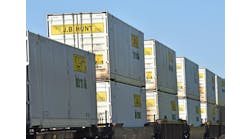More and more supply chains are interlinked with other enterprises, escalating the risk of spreading someone's bad habits. And due to their global nature, supply chains are also more vulnerable to geopolitical events and natural disasters. Resisting the consequences of these threats requires visibility.
See Also: Global Supply Chain Logistics Management
Supply chain visibility is made possible through a combination of machine sensors, computer software and human eyeballs. This article is about how two manufacturers combine these elements in different ways to improve their supply chain insights.
Insights into What's Outsourced
The Caldrea Company has two main product lines: The Caldrea line and the Mrs. Myersbrand. Both represent a full suite of home cleaning and personal care products that are friendly to the environment and easy on the nose.
But of more importance to Caldrea's supply chain managers is how easy it is to see how these products move and where. The reason supply chain visibility is so important to them is the company outsources almost everything about these products—except for marketing and product development. It outsources its production to contract manufacturers and all of its fulfillment to third party logistics (3PL) service providers.
It uses the manufacturing module that comes with Infor's Syteline ERP system to schedule when it needs to reorder product from its contract manufacturers. An add-on forecasting module helps the company predict what it should be making and when, based on customer demand.
While Caldrea had a good idea of what its contract manufacturers were making and when, it didn't always know what was on the assembly line at any given moment. With its original service provider that was all right because the two companies had some history together.
But things changed when Caldrea brought a new 3PL into the mix. This happened when Caldrea moved its fulfillment operations to Chicago so it could save on transportation costs. Unfortunately the internal startup costs turned out to be higher than expected due to the learning curve about how each other worked.
"We tried to use the same integrations we used with our former 3PL," says Mike Johnson, IT manager of The Caldrea Company. "That was a rough four months. We overestimated how well our other 3PL knew us, and that allowed us to be a little bit sloppy with letting them execute. We would give them dates by when product had to arrive at the customer dock and they executed to that plan."
However, while the new 3PL took all that data in, it only looked at the last day it could ship and it tried to ship everything on that last day. Some of Caldrea's orders are so big that that couldn't be a viable strategy. However, getting the new 3PL to adhere more closely to Caldrea's preferred practices proved difficult.
"In the new 3PL's world we're a small fish," Johnson explains. "To our other 3PL we were a gigantic whale. We went from being a company's largest customer to being one of 400 3PL clients."
That required Caldrea to generate more reports to let its internal people know if and when things started to go off track with their shipping windows. Did this make Johnson consider bringing those operations in-house?
"To go out and find your warehouse space, hire people, especially in the Chicago market where you might not have connections, working with a 3PL still made sense," he answers. "It's just that we're learning how to work with them and we're now gaining more visibility of what's going on in their system."
Caldrea now knows that for every order it sends to the 3PL there are about 20 different statuses. It will know when that order has been released to the floor, when something has been picked for it and when it has gone into routing for the truck. Caldrea's customer service people will pull up an order in the ERP and every ten minutes will get feeds up to the point it ships.
One of the most important lessons Johnson can impart from this conversion is that success is all in the timing. His staff spent six months moving the company's smaller brands to the new 3PL and things went fine. But during the cutover in December Caldrea experienced the "perfect storm."
"They weren't ready for us," Johnson says. "We should have been onsite more, just to see how many people they had planned to work with us. They started falling behind, then we got hit with the Christmas holiday, and we couldn't tell people they had to work on the holiday to get our stuff shipped. At the same time we had customers who were a week late getting shipments and at holiday time you just can't do that to the big retailers."
So the moral of visibility is to stay on top of details by receiving data feeds directly from your partner.
"We can bring in this data from our partners whether from the manufacturing side, the purchase order side or fulfillment, and create an intelligent data object," Johnson explains. "If we're going into the system looking at the lines, and the availability of inventory for those order lines, we put a tab on the order that shows the status of this order at our 3PL in Chicago. Our customer service people go to the same place they're used to going to look at orders and they can now see all the information that comes back from the 3PL once it shipped—all the package information by carton, the tracking number from each package, the bill of lading number, and we have a link for them to track the package through UPS or FedEx. We don't have to go to 30 different portals for all the different partners we use for contract manufacturers. The data they need is in the ERP system."
Orders that were supposed to ship but haven't are indicated by yellow or red indicators, depending on how long they've been delayed. A report also goes to the 3PL indicating it missed shipment on this order, and that Caldrea needs immediate feedback.
"Now our suppliers don't have to take as many phone calls from us, and if there's something we think should be happening they'll get the alerts the same time we are," Johnson says.
The major point of all this is never to take service for granted when dealing with a 3PL.
"You need to inspect what you expect," he concludes. "If you're expecting this 3PL to execute on these ten things, you better have a way to measure those ten things and a way to get visibility to those ten things. Don't just hope it will happen."
In Defense of a Common Vision
Dave Brantner respects the philosophy of "seeing is believing." As vice president of sourcing and contracts for Pratt & Whitney, he's responsible for making sure his company's engines make it to the production lines on time for customers in civilian and military aviation. From a sourcing and operations standpoint, he is responsible for sourcing and contracts affecting all his company's units, so his team coordinates all buying and sourcing plans and production readiness efforts into one supply chain.
That supply chain includes 400 key product partners and suppliers around the world. To deal with all of them effectively, Pratt & Whitney established regional hubs to make sure it has people on the ground to work with suppliers in a hands-on way. In this context, visibility means sharing demand signals and schedules.
"We take it upon ourselves to make sure our strategy is clear in our own house before we step outside," Brantner says. "We have a strategic sourcing review board that decides where we'll source—what we'll make, what we'll buy, what we'll source to our own divisions and what we'll put out on contract to the supply chain. We get that locked down and then execute agreements with key suppliers. The key for visibility is making sure they understand the demand and in our case the significant industrial ramps that will be necessary over the next three or four years."
Pratt & Whitney's suppliers must be willing to invest in visibility too, so P&W collaborates with them to determine production readiness, including not only when they need to produce parts, but when they need to have a contract in place and backing up from there, when they must invest in equipment and hire and train people to be ready for the next production ramp.
"In our industry because we have product lifecycles that are upwards of 40 years, our suppliers are a little more used to it than companies in other supply chains," Brantner says. "We have a very complex product that's highly regulated, so many of our parts are serialized and tracked. We have to know birth records, we have to know where a part's metal came from because the FAA and the government require that when we put our engine into a military product we can trace it back if there are any issues."
But P&W also buys parts that are used in industrial businesses, which means some suppliers are less used to this kind of long-term intimate relationship. The manufacturer makes sure these suppliers know if they don't meet P&W's ramp schedules they won't be supplying them.
Although P&W uses several web-based tools to achieve supply chain visibility, Brantner believes if you rely solely on such tools you'll eventually be surprised.
"We combine those tools with a personal touch," he says. "We have regional offices with people on the ground. There's no substitute for our own representative walking through the factory and seeing where the material is. We can't afford to expand that with every single supplier so we triage that and work it from the top down—from the critical suppliers, through the longest lead time suppliers. We've instituted a process for delivery quality assurance called the Six Pack, where we have teams that go out and do six pack reviews with all of our critical suppliers. They review demand and capacity, the supplier's buffer strategy, they look at quality, at where the raw material has come into the system and then, of course, work-in-process (WIP) through their factory to make sure the line of balance meets our needs."
In summary, P&W has a large and complex supply chain spread across the world that needs to be in sync so it can anticipate and meet ramps in demand. Coordinating where various capabilities will be and where its own capacity will be to pull it all together requires collective visibility.
"Identifying and securing capacity and capability to meet industrial ramp, and then coordinating the complex logistics of getting those parts into our factories and assembly centers on time to meet this ramp is my single biggest concern," Brantner advises. "I can't point to any one piece of software for visibility."
Where global supply chains are concerned, maintaining a native knowledge of export laws is another vital aspect of visibility.
"So many companies are getting caught these days with export violations that they're unaware of," he adds. "We're all dealing with high technology things, and when you manage a global supply chain you must be aware of the regulations and controls put upon us by the U.S. government."
That's why P&W either dual sources key components or makes sure suppliers have duplicative capability.
"You do not want to be caught after a natural disaster without supply," Brantner concludes.
That kind of visibility is called foresight.





